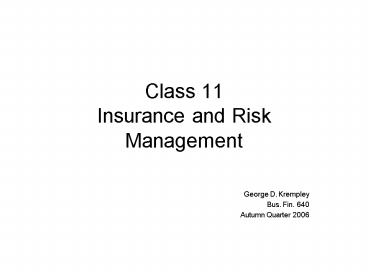Class 11 Insurance and Risk Management - PowerPoint PPT Presentation
1 / 29
Title:
Class 11 Insurance and Risk Management
Description:
Life insurance is valued policy, not a contract of indemnity. ... Determining the Amount of Life Insurance to Own Needs Approach. Estate clearance fund ... – PowerPoint PPT presentation
Number of Views:4397
Avg rating:5.0/5.0
Title: Class 11 Insurance and Risk Management
1
Class 11Insurance and RiskManagement
- George D. Krempley
- Bus. Fin. 640
- Autumn Quarter 2006
2
Premature Death
- Death of a family head with outstanding
unfulfilled financial obligations - Examples
- Dependants to support
- Children to educate
- Unpaid mortgage
3
Life Expectancy
- Climbed to record high of 77.2 years in 2001
- Sharp reduction in chance of premature death
since 1900 due to - Significant medical breakthroughs
- Health improvements arising from better economic
conditions and higher incomes - Public health and sanitation improvements
4
EXHIBIT 16.1 Improvements in Life Expectancy
over the Past Century
5
Costs of Premature Death
- Family shares of deceaseds wage earnings lost
forever - Additional expenses
- Funeral expense
- Uninsured medical bills
- Estate settlement costs
- Federal estate taxes
6
Costs of Premature Death (cont.)
- Insufficient income causes some families to
experience a reduced standard of living - Non-economic losses
- Emotional grief
- Loss of parental role model
- Loss of guidance and counseling for children
7
What is the insured event?
- Life insurance is valued policy, not a contract
of indemnity. - The insured event is the uncertainty of the time
of death - Because of this uncertainty, the family head may
die with outstanding financial obligations
8
Economic Justification of Life Insurance
- Economic justification arises if
- The Insured earns an income
- Others are dependent on that income for at least
part of their financial support - Premature death creates the loss of wage earning
ability upon which others are dependent
9
Premature Death Financial Impact Depends on
Family Make-up
- Single People
- Single-Parent Families
- Two-Income Earners
- Traditional Families
- Blended Families
- Sandwiched Families
10
Methods for Determining the Amount of Life
Insurance to Own
- Human life value approach
- Needs approach
- Capital retention approach
11
Determining the Amount of Life Insurance to
OwnNeeds Approach
- Estate clearance fund
- Income during readjustment period
- Income during dependency period
- Life income to surviving spouse
- During blackout period
- After blackout period
- Special needs
- Mortgage redemption fund
- Educational fund
- Emergency fund
- Retirement Needs
12
EXHIBIT 16.2 How Much Life Insurance Do You Need?
13
Product Overview
- Term - Pure life insurance
- Cash value policies
- Pure life insurance Savings accumulation
- Examples
- whole life
- universal life
- variable life
14
Product Overview
- Can obtain savings accumulation by surrendering
the policy - Why bundle death protection savings
accumulation? - Tax advantaged method of saving
15
EXHIBIT 16.3 Relationship Between the Net Amount
at Risk and Legal Reserve
16
Terminology
- Death benefit amount beneficiaries receive
- Cash value amount of savings accumulation
- Death protection amount of pure death
protection death benefit - cash value - Face amount stated amount of coverage
17
Term Insurance
- ¼ of policies
- Almost ½ of death protection purchased
- Guaranteed renewable
- Premium increases over time
18
Whole Life Insurance
- Policy period ends when insured reaches 100
- Equivalent to endowment policy to 100
- Premiums
- single premium
- limited pay
- continuous premium
19
Whole Life Insurance
- Premiums generally do not increase over time
- Probability of dying increases over time
- Higher upfront premiums than with term
- Policyholder prepays part of the cost of future
death protection - entitled to prepayments if policy is surrendered
- this is the cash value (savings accumulation)
20
Whole Life Insurance
- If insured dies,
- beneficiaries receive face amount
- death protection cash value
- Structured so
- cash value ? over time
- death protection ? over time
21
Whole Life Insurance
22
Tax Treatment of Life Insurance
- Death benefits are not taxed
- Income tax is not paid on increases in cash value
while the policy is in force - Upon surrender, income tax is paid on
- Cash surrender value - sum of all premiums
- sum of all policyholder dividends
23
Implications of Tax Treatment
- Implicit returns on savings accumulation
- Escape taxation if insured dies
- Tax deferred if the policy is surrendered
- Partially taxed if policy is surrendered
- Amount which is taxed is less than implicit
return because part of premiums is cost of death
protection
24
State Laws Require Rates To Be
- Adequate
- Not excessive
- Not unfairly discriminatory
25
Business Rate-Making Objectives
- Simplicity
- Stability
- Responsiveness
- Encourage loss prevention
26
EXHIBIT 27.1 Commissioners 1980 Standard
Ordinary Mortality Table, Male Lives
27
EXHIBIT 27.1 (continued) Commissioners 1980
Standard Ordinary Mortality Table, Male Lives
28
EXHIBIT 27.2 Present Value of 1 at 5 Percent
Compound Interest
29
EXHIBIT 27.3 Figuring the NSP for a Five-Year
Term Insurance Policy































